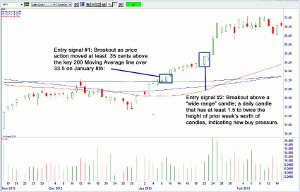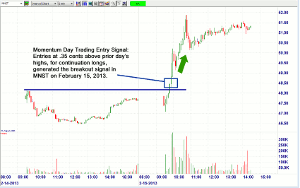When markets are volatile, it’s important to scan for and trade those stocks that have the best initial trading momentum to help ensure follow through for trading entries, notes veteran trader Ken Calhoun of TradeMastery.com and DaytradingUniversity.com.
In this series of articles, we’ll look at specific little-known technical trading setups for a variety of intraday and swing trading chart examples from current markets to learn from.
Swing Trading with Wide-Range Candles and Moving Average Crossovers
The first chart to look at is a 90-day daily candlestick chart, because these show powerful trends and key support and resistance areas. Traders often look for new entries once price action has broken above key moving average lines.
We like to use 50, 100, and 200 simple moving averages (MAs) to identify entry signals. It’s important to wait until price has moved at least .35 above a major moving average to enter, to help filter out false breakouts.
In Figure 1, Bristol-Myers Squibb Co. (BMY), you can see that an entry signal was generated above the second 33.5 MA breakout on January 8, as price got at least .35 above the black 200 MA line in BMY. The second buy entry signal was generated once price created a “wide range candle”; which is a candle whose height is at least 1.5 to twice the height of prior weeks’ candles.
This shows that new momentum is coming into the stock, and is worth considering for a breakout buy on new highs above the candle. Maximum stop losses for all swing trades are no more than 1.5 points.
Trading on Momentum Gap Continuations: Trading High Volume Gaps
While it can be tricky to time gap trading entries on the day of a major gap (due to occasional pullbacks), one potentially effective strategy involves being able to buy on the day following a major gap, in the trend of the gap. This is shown in Figure 2, America Online, Inc. (AOL), in which an entry signal was generated on February 11, 2013.
NEXT PAGE: Day Trading Momentum Signals
|pagebreak|The high volume positive gap up that occurred on February 8 “sets the momentum trading stage” for a long trade on the next trading session, if the gap price action continues (which it did in this case). As a general rule of thumb, minor gap continuations, e.g. gaps of no more than 10-15% (in AOL’s case, that’s a three-point limit since it was a $30 stock, pre-gap) are best traded on momentum continuations in the direction of the gap.
Major gaps of 5-6 or more points may occasionally “fill”, or drop back into the gap range, so that’s why we prefer to wait and see what price action does on the day following the gap, for an entry.
Day Trading Momentum Signals
There are many signals that astute day traders use to help spot potential momentum breakout entries. In this article, we start by looking at my simple favorite pattern, which is buying roughly .35 cents above the prior day’s high, for a continuation breakout long. In Figure 3, Monster Beverage Corp. (MNST), this is shown clearly, as a long signal was generated at (48.1 + .35 = 48.45) for a long entry.
It’s very important when looking for intraday trading candidates that traders avoid cheap stocks under $20/share, because they usually have narrow trading ranges and/or light volume, making them difficult to trade. It’s much better to trade instruments priced $20-$70/share (the author’s favorite price range is $30-$50/share instruments, like this MNST chart), that have a) a minimum of 1.0 point or wide prior day’s high-low range, and b) trade at least 15k shares per minute. This provides optimum liquidity and volatility for trading momentum trade entries.
With outstanding volatility in select stocks, ETFs, and other instruments, it’s an ideal time to plan for how to take advantage of strong momentum breakout day and swing trades during the upcoming months ahead. In our next article, we’ll look at additional strategies to help trade momentum moves for day and swing trading stocks and ETFs.
Ken Calhoun is a trading professional who has traded millions of dollars of equities since the 1990s, and is the producer of multiple award-winning trading courses and video-based training systems for active traders. He is a UCLA alumnus and is the founder of TradeMastery.com and DaytradingUniversity.com, popular online educational sites that reach tens of thousands of active traders worldwide.





















